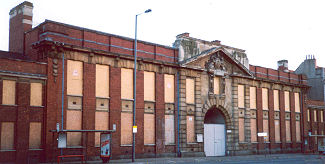Bristol
Whiteladies Road Clifton
Redcliff Hall (Drill Hall)
32 Park Row
Trinity street, College green
St Georges
Queens road, Clifton
St Michael's Hill
Colston Fort, Montague Place, Kingsdown
Glenavon, Daisy road, Eastville
Drill Hall, Old Market street
Redcliff Hall (Drill Hall)
32 Park Row
Trinity street, College green
St Georges
Queens road, Clifton
St Michael's Hill
Colston Fort, Montague Place, Kingsdown
Glenavon, Daisy road, Eastville
Drill Hall, Old Market street
Whiteladies
Road Clifton:
1st South Midland (Gloucester) Brigade, Royal Field Artillery
Head quarters, 1st and 2nd Gloucestershire batteries
1st South Midland Ammunition Column.
Originally the 1st Gloucestershire Artillery Volunteers (Gloucester & Somerset) [No. 13 Co. Drill hall, Redcliff hill] (Kelly, 1914)
32 Park Row:
South Midland Divisional head quarters, 1st and 2nd South Midland Field Companies Royal Engineers (Kelly 1914)
HQ, 1,2,3,4 Sections South Midland Divisional Telegraph Company Royal Engineers
Trinity street, College green:
2nd Gloucestershire Royal Engineers (The Bristol Engineer Volunteer Corps.)
Head quarters, Trinity street, College green (Kelly 1902)
St George’s:
F' 4 Gloucestershires
Queens road, Clifton:
HQ, A-E, G, H 4 Gloucestershires
St Michael’s Hill:
HQ, A-H 6 Gloucesteshires
Colston Fort, Montague Place, Kingsdown:
HQ, A, B, C Sect 3rd S Midland Field Ambulance RAMC
2nd Southern General Hospital
Eastville:
Bristol Troop of the Royal Gloucestershire Hussars (Imperial Yeomanry), forming part of the D Squadron. Head quarters, Glenavon, Daisy road, Eastville.’
Kelly, 1902, makes several references to units in Bristol. He records:
‘Adjoining the Bristol Museum are the head quarters of the 1st (City of Bristol) Volunteer Battalion, Gloucestershire Regiment, formed 14th September 1859; the offices of the 1st Gloucestershire (Bristol) Rifles Head Quarters Company Limited are in Queens road.’
And:
‘In the city, at Eastville, are the head quarters of the Bristol Troop of the Royal Gloucestershire Hussars (Imperial Yeomanry), forming part of the D Squadron.’ Kelly also notes, ‘D (or Doddington) Squadron….Accoutrement depôt, Carriage Company, Broadmead; Head quarters, Glenavon, Daisy road, Eastville.’
The Drill Hall in Old Market Street
This was purchased by developers in ? to be converted into apartments. It was an historic building which was previously used as a sugar warehouse and sugar refinery by Bristol Sugar Refining Company and, later, the Bristol & West Sugar Refinery. When the company went bankrupt, Sir H H Wills arranged an exchange of land so that the Gloucestershire Territorial Force Association could move from Queens Road in Clifton to the Drill Hall.
The Drill Hall was used as a billet for the first of a large contingent of black American soldiers stationed in Bristol prior to D-Day, 1944 and racial tensions led to a brawl on July 15th, 1944.
Recently it was used as a postal sorting office (2005). It is now under development for use as business premises and flats. (2007)
Ashton Gate
Follow the link to view an amazing complex of drill hall buildings, which command interest, although falling outside the strict scope of the Project.
1st South Midland (Gloucester) Brigade, Royal Field Artillery
Head quarters, 1st and 2nd Gloucestershire batteries
1st South Midland Ammunition Column.
Originally the 1st Gloucestershire Artillery Volunteers (Gloucester & Somerset) [No. 13 Co. Drill hall, Redcliff hill] (Kelly, 1914)
32 Park Row:
South Midland Divisional head quarters, 1st and 2nd South Midland Field Companies Royal Engineers (Kelly 1914)
HQ, 1,2,3,4 Sections South Midland Divisional Telegraph Company Royal Engineers
Trinity street, College green:
2nd Gloucestershire Royal Engineers (The Bristol Engineer Volunteer Corps.)
Head quarters, Trinity street, College green (Kelly 1902)
St George’s:
F' 4 Gloucestershires
Queens road, Clifton:
HQ, A-E, G, H 4 Gloucestershires
St Michael’s Hill:
HQ, A-H 6 Gloucesteshires
Colston Fort, Montague Place, Kingsdown:
HQ, A, B, C Sect 3rd S Midland Field Ambulance RAMC
2nd Southern General Hospital
Eastville:
Bristol Troop of the Royal Gloucestershire Hussars (Imperial Yeomanry), forming part of the D Squadron. Head quarters, Glenavon, Daisy road, Eastville.’
Kelly, 1902, makes several references to units in Bristol. He records:
‘Adjoining the Bristol Museum are the head quarters of the 1st (City of Bristol) Volunteer Battalion, Gloucestershire Regiment, formed 14th September 1859; the offices of the 1st Gloucestershire (Bristol) Rifles Head Quarters Company Limited are in Queens road.’
And:
‘In the city, at Eastville, are the head quarters of the Bristol Troop of the Royal Gloucestershire Hussars (Imperial Yeomanry), forming part of the D Squadron.’ Kelly also notes, ‘D (or Doddington) Squadron….Accoutrement depôt, Carriage Company, Broadmead; Head quarters, Glenavon, Daisy road, Eastville.’
The Drill Hall in Old Market Street
This was purchased by developers in ? to be converted into apartments. It was an historic building which was previously used as a sugar warehouse and sugar refinery by Bristol Sugar Refining Company and, later, the Bristol & West Sugar Refinery. When the company went bankrupt, Sir H H Wills arranged an exchange of land so that the Gloucestershire Territorial Force Association could move from Queens Road in Clifton to the Drill Hall.
The Drill Hall was used as a billet for the first of a large contingent of black American soldiers stationed in Bristol prior to D-Day, 1944 and racial tensions led to a brawl on July 15th, 1944.
Recently it was used as a postal sorting office (2005). It is now under development for use as business premises and flats. (2007)
Ashton Gate
Follow the link to view an amazing complex of drill hall buildings, which command interest, although falling outside the strict scope of the Project.



© All material is copyright - refer to the
Terms of Use
the first attempt at content
Introduction
About
Anatomy
Drill
 Database
Database
 Memorabilia
Memorabilia
Resources Glossary
Saving Halls Participate Contact What's New? Terms of Use
Drill
 Database
Database Memorabilia
MemorabiliaResources Glossary
Saving Halls Participate Contact What's New? Terms of Use
The Drill Hall Project - Charting a neglected legacy